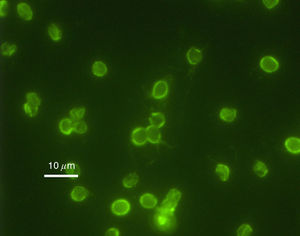Shock chlorination: Difference between revisions
No edit summary |
No edit summary |
||
| Line 28: | Line 28: | ||
===Epidemic Outbreaks=== | ===Epidemic Outbreaks=== | ||
< | [[Image:Cryptosporidium1.jpeg|thumb|300px|right|Immunofluorescence of <i>Cryptosporidium</i>, the microbe that caused an epidemic in Milwaukee in 1993. Over 104 deaths were credited to the waterborne microbe . Courtesy: [http://www.epa.gov/microbes/cpt_seq1.html H.D.A Lindquist (EPA)]]] | ||
==Methods== | ==Methods== | ||
| Line 45: | Line 45: | ||
[Sample reference] [http://ijs.sgmjournals.org/cgi/reprint/50/2/489 Takai, K., Sugai, A., Itoh, T., and Horikoshi, K. "''Palaeococcus ferrophilus'' gen. nov., sp. nov., a barophilic, hyperthermophilic archaeon from a deep-sea hydrothermal vent chimney". ''International Journal of Systematic and Evolutionary Microbiology''. 2000. Volume 50. p. 489-500.] | [Sample reference] [http://ijs.sgmjournals.org/cgi/reprint/50/2/489 Takai, K., Sugai, A., Itoh, T., and Horikoshi, K. "''Palaeococcus ferrophilus'' gen. nov., sp. nov., a barophilic, hyperthermophilic archaeon from a deep-sea hydrothermal vent chimney". ''International Journal of Systematic and Evolutionary Microbiology''. 2000. Volume 50. p. 489-500.] | ||
<br>Edited by | <br>Edited by Erika Jensen, student of [mailto:slonczewski@kenyon.edu Joan Slonczewski] for [http://biology.kenyon.edu/courses/biol116/biol116_Fall_2013.html BIOL 116 Information in Living Systems], 2013, [http://www.kenyon.edu/index.xml Kenyon College]. | ||
<!--Do not edit or remove this line-->[[Category:Pages edited by students of Joan Slonczewski at Kenyon College]] | <!--Do not edit or remove this line-->[[Category:Pages edited by students of Joan Slonczewski at Kenyon College]] | ||
Revision as of 00:10, 4 November 2013
Introduction
Select a topic that includes microbes (bacteria, protist, fungi, or algae). Any kind of topic is possible, because all living organisms and ecosystems include microbes. For example, Google "kangaroo bacteria".
Compose a title for your page. Type your exact title in the Search window, then press Go. The MicrobeWiki will invite you to create a new page with this title.
Open the class template page in "edit." Copy ALL the editable text. Then go to YOUR OWN page; edit tab. PASTE into your own page, and edit.

At right is a sample image insertion. It works for any image uploaded anywhere to MicrobeWiki. The insertion code consists of:
Double brackets: [[
Filename: PHIL_1181_lores.jpg
Thumbnail status: |thumb|
Pixel size: |300px|
Placement on page: |right|
Legend/credit: Electron micrograph of the Ebola Zaire virus. This was the first photo ever taken of the virus, on 10/13/1976. By Dr. F.A. Murphy, now at U.C. Davis, then at the CDC.
Closed double brackets: ]]
Other examples:
Bold
Italic
Subscript: H2O
Superscript: Fe3+
Microbial Agents
Include some current research, with at least one image.
Epidemic Outbreaks

Methods
Include some current research, with a second image.
Success of Procedures
Include some current research, with a second image.
Alternative Methods
Include some current research, with a second image.
Conclusion
Overall text length should be at least 1,000 words (before counting references), with at least 2 images. Include at least 5 references under Reference section.
References
Edited by Erika Jensen, student of Joan Slonczewski for BIOL 116 Information in Living Systems, 2013, Kenyon College.
